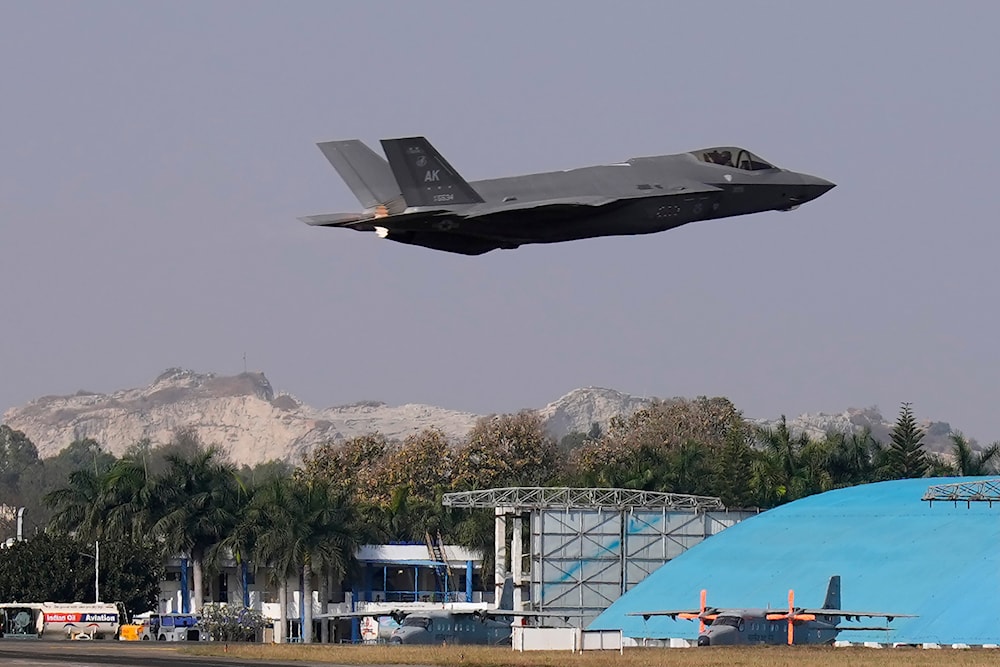Canada weighs substitutes for US-built F-35 stealth fighters
The announcement by Canada's defence minister comes as the new Prime Minister Mark Carney promises to resist Trump's hostile policies toward the country.
-

US Air Force fighter aircraft F-35 takes off to perform on the fourth day of the Aero India 2025, a biennial event, at Yelahanka air base in Bengaluru, India, Thursday, Feb. 13, 2025 (AP)
Canada is rethinking its plans to purchase US-built F-35 stealth jets, Canadian Defense Minister Bill Blair announced following his appointment to the position by the new Prime Minister Mark Carney.
The Defense Minister, who came in from Trudeau's government, announced on Friday after his appointment that Canada is actively looking into alternatives to the US stealth fighter, noting that he is planning to hold talks with rival aircraft makers.
"It was the fighter jet identified by our air force as the platform that they required, but we are also examining other alternatives — whether we need all of those fighter jets to be F-35," Blair stated during an interview for CBC, where he noted that discussions are being held to identify Canada's best options.
The defense minister indicated that while the first batch of F-35 fighter jets might be accepted, the rest of Canada’s future fleet could include aircraft from European manufacturers, such as the Swedish-made Saab Gripen, which was the runner-up in the initial selection process.
He noted that the newly appointed PM had tasked him with exploring these possibilities further, including engaging in discussions with other sources to assess potential alternatives and the prospect of assembling some of these fighter jets domestically.
Many Canadians want to cancel the $19-billion purchase and choose aircraft that are not made or maintained in the United States.
This closely follows the swearing-in of Mark Carney as Canada's new Prime Minister, succeeding the liberal Justin Trudeau, who resigned following growing disapproval of his handling of the cost-of-living and housing crises.
Canada's new PM arrives amid US tensions
Carney was sworn in as the new prime minister on March 14, as the ruling Liberal party places their hopes on the successor's experience leading two central banks through major crises to reassure Canadians during the risk of a serious trade war.
Carney previously described Trump's hostile stance toward Canada and his tariff policies as the most serious political challenge Canada has faced in a generation, while he tries to portray himself as uniquely suited to navigate Ottawa through a trade war with the US, a country Canada can "no longer trust" according to the newly sworn-in PM.
Foreign Minister Mélanie Joly said at a G7 meeting that the new prime minister would bring fresh energy to US-Canada relations. She noted that she and US Secretary of State Marco Rubio were working to arrange a call between US President Donald Trump and Prime Minister Carney within the next few days.
After taking the oath of office, the newly sworn-in prime minister firmly dismissed Trump’s attempt to annex Canada, emphasizing that his country "will never, ever, in any way, shape or form, be part of the United States," while also expressing hope that his government could find ways to cooperate with the Trump administration.
In response to Trump’s tariffs on Canada, Trudeau introduced C$30 billion in tariffs on the United States, with Carney stating that his government would maintain these tariffs "until the Americans show us respect."
"Carney is arriving at a good time. He has emerged as a figure people seem to trust to take on Donald Trump," politics professor Felix Mathieu told AFP, with Carney saying that he was ready to figure out a trade deal with the US, emphasizing that Canada's sovereignty must be respected under any negotiations.

 4 Min Read
4 Min Read








